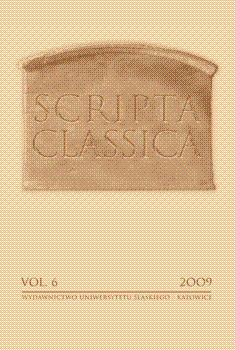The Language and Style of Cassia’s Secular Poetry
The Language and Style of Cassia’s Secular Poetry
Author(s): Katarzyna WarcabaSubject(s): Language and Literature Studies
Published by: Wydawnictwo Uniwersytetu Śląskiego
Keywords: Byzantium; antiquity; Cassia; poetry; language
Summary/Abstract: “Cassia having lost her chance to be an empress, put on a nun’s habit and started writing many canons, stichera and other remarkable poetry” we read in a work entitled “Scriptores originum Constantionopolitanarum” about the only Byzantine female poet who wrote not only religious but also secular poetry. In this article I shortly describe Cassia’s story and her works but the main subject of the text is the issue of language and style of her secular poetry. First, I present definitions of Byzantine levels of style and their characteristics. The analysis of Cassia’s language in some of the most clear examples leads to the conclusion that we can classify Cassia’s gnomai as an example of the middle style of Byzantine literature. She usually uses Attic Greek, but she does not avoid some popular expressions; she imitates classical models as well as the Bible and contemporary writers; she is creative in “proper” Attic word formation, but she also creates a noun based on an occupation which was not known to Attic authors, which was considered as “wrong practice”. All in all there are some vernacular elements in her poetry as well as posh, classical ones but they are integrated in such a manner that Cassia’s language is coherent, understandable and pleasant. I also do a short analysis of the dodecasyllable, a metre used by Cassia in her poems and I come to the conclusion that Cassia’s gnomai are written in purely unprosodic dodecasyllable. This fact determined Cassia’s poetry to be seen as not “classical” at the very first glance. But since she used this “vernacular” metre for her sentences written in learned language we can see it as a final proof that Cassia’s gnomai are a part of the development of Byzantine literature as a link between the classical, posh, and official literature and the later, vernacular literature on which it depended.
Journal: Scripta Classica
- Issue Year: 2009
- Issue No: 6
- Page Range: 137-149
- Page Count: 13
- Language: English

